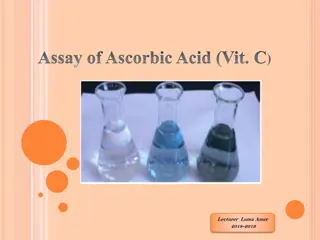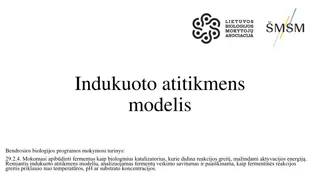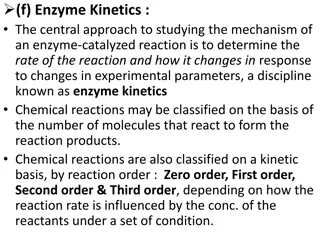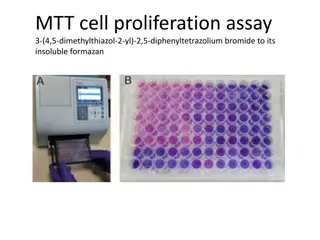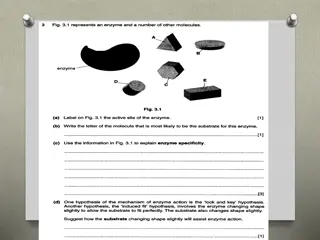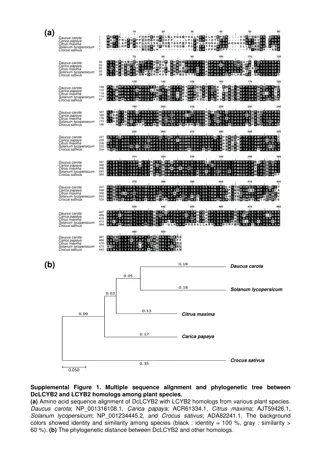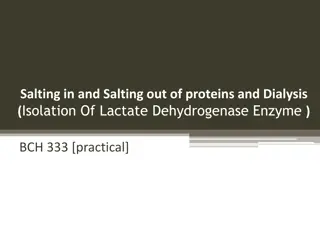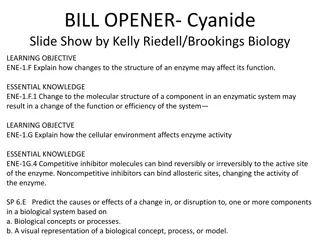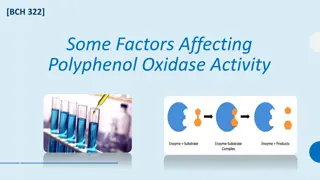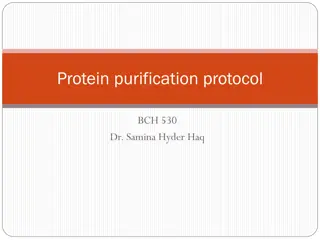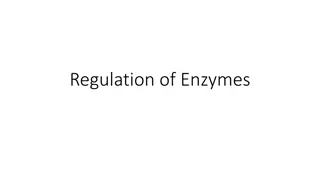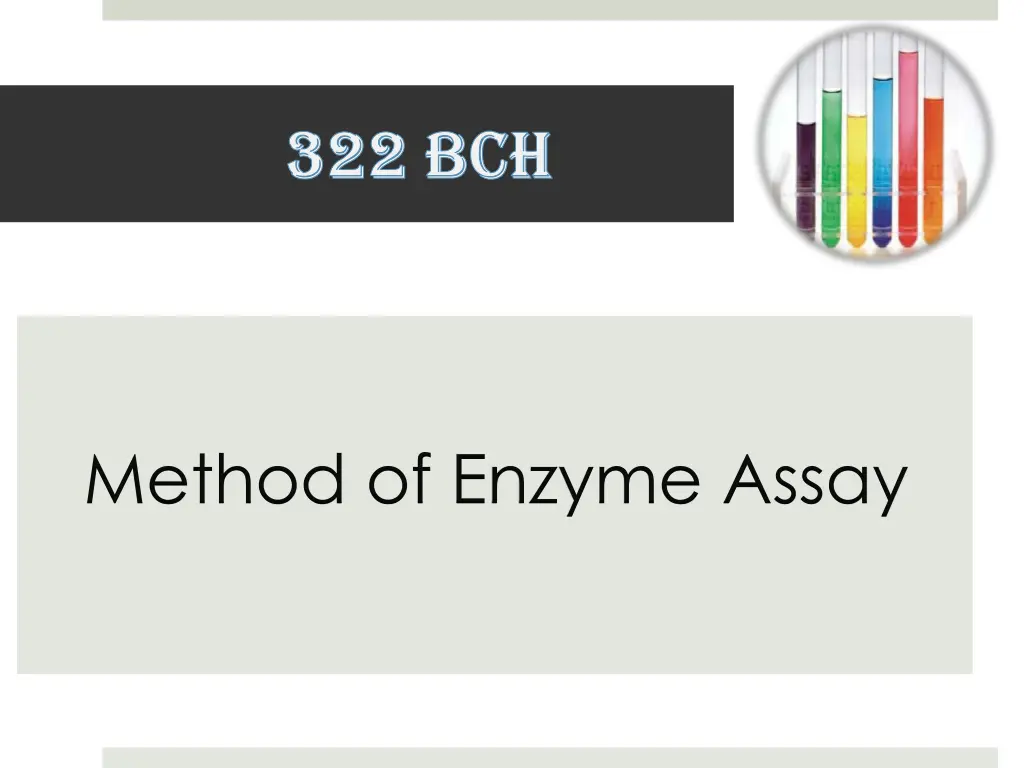
Different Methods for Enzyme Activity Determination
Learn about various laboratory methods for measuring enzyme activity, including fluorescence, manometric, electrode, polarimetric, and spectrophotometric assays. Discover the importance of blank solutions and the use of different wavelength ranges in spectrophotometry.
Download Presentation

Please find below an Image/Link to download the presentation.
The content on the website is provided AS IS for your information and personal use only. It may not be sold, licensed, or shared on other websites without obtaining consent from the author. If you encounter any issues during the download, it is possible that the publisher has removed the file from their server.
You are allowed to download the files provided on this website for personal or commercial use, subject to the condition that they are used lawfully. All files are the property of their respective owners.
The content on the website is provided AS IS for your information and personal use only. It may not be sold, licensed, or shared on other websites without obtaining consent from the author.
E N D
Presentation Transcript
322 BCH 322 BCH Method of Enzyme Assay
Objective To study the different methods for determining enzyme activity.
Enzyme measuring enzymatic activity. assays: Are laboratory methods for All consumption of substrate or production of product over time. S P + E enzyme assays measure either the E Different enzymes require different estimation methods depending on the type of reaction catalyzed, the nature of S and P or coenzyme.
1.Fluorescence methods: Using a fluorometer . ** e.g. NAD+and NADP+do not fluoresence in their oxidized forms, but the reduced form have a blue fluorescence reduction reaction. 2.Manometric methods: Using a manometer. ** It is suitable for reactions in which one of the component is a gas. e.g. Oxidases Decarboxylase(CO2output) (O2 uptake),
3. Eletrode Methods: Using a pH meter. ** Reactions which involve the production of acids where H+conc. is measured. 4. Polarimetric Method: use polarimeter. isomerases that convert ** For one isomer another. to e.g. D-glucose L-glucose
http://t2.gstatic.com/images?q=tbn:fjqeTUL_ACajrM:http://www.eng.auburn.edu/~simonal/spectrophotometer.JPGhttp://t2.gstatic.com/images?q=tbn:fjqeTUL_ACajrM:http://www.eng.auburn.edu/~simonal/spectrophotometer.JPG 5. Spectrophotometric methods. In spectrophotometric assays, you follow the course of the reaction by measuring a change in how much light the assay solution absorbs.
Wavelength in this instrument is divided into: -Invisible range(ultraviolet UV ) from 100 to 360 nm [Quartz cuvette are used] -Visible range (400 -700 nm) [Glass or plastic cuvette are used] [ If the light is in the visible region you can actually see a change in the color of the assay, these are called colorimetric assays ] What is blank solution? It is a solution that contains everything except the compound to be measured.
When the Spectrophotometric methods can be used? 1- cases in which product absorb but not the substrate. e.g. Fumarate hydratase Fumarate malate 2- the Co-enzyme undergoes change in absorption upon reduction or oxidation Oxidized form Reduced form NAD NADP NADH NADPH If reduced form was product: increase the absorbance / min If reduced form was substrate : decrease the absorbance / min
Alanine transaminase (ALT) ALT is an enzyme that catalyzes a type of reaction (transamination) between an amino acid and -keto acid. It is important in the production of various amino acids.
ALT diagnostic importance ALT is found in serum (at low level) but is most commonly is associated with the liver. thus , an elevated level ALT is a sensitive index of acute hepatocellular injury. Elevated serum ALT level are found in hepatitis, cirrhosis , and obstructive jaundice. NORMAL RANGE OF ALT: ( up to 42 ) U/L males ( up to 32 ) U/L females
Enzyme assays can be split into two types: Continuous assays, where the assay gives a continuous reading of activity. Discontinuous (Endpoint) assays, Where the reaction is stopped and then the concentration of substrates/products determined. Both types of enzyme assays will be applied in this lab on ALT
Principle of Continuous Assay 1- ALT present in serum sample catalyzes the transfer of an amino group from alanine to -ketoglutarate in the following reaction: Alanine + - ketoglutarate Pyruvate + glutamate 2- Then, the pyruvate formed in the reaction is reduced to L-Lactate by Lactate dehydrogenase (LDH) found in ALT reagent . Pyruvate + NADH+H+ L-Lactate+ NAD++H2O 3- The absorbance at 340nm is measured each minute without stopping the reaction, resulting in decreased readings due to the oxidation of NADH
Method Pipette into clean and dry test tubes: ALT Reagent 3 ml Pre-warm at 37 C for 3 minutes and add Serum Sample 0.2 ml ml l (x 1000) Mix and incubated at 37 C for 1 minute, then read absorbance ( at 340 nm against distilled water ) every minute for 3 minutes) and determine A/min Choose the following on the spectrophotometer: 2) Applications 2) Simple Kinetics wave length (340 nm) 1) Seconds Duration (180 sec = 3 min) Intervals (60 sec= 1 min) Print Data Table (off) Press start (2 times)
Results Time Absorbance 340nm A/min=((A1-A2)+(A2-A3))/2 1 min A1 2 min A2 3 min A3 Calculations ALT Activity ( U/L) = A/min x 1768 ALT Activity (U/L) =
Principle of Discontinuous Assay In this method ALT catalyzes the following reaction Alanine + a-ketoglutarate pyruvate + glutamate ALT is assayed by following formation of pyruvate. The (DNPH) dinitrophenylhydrazone. So that it may be measured at 546nm. addition stops of the acidic reaction 2,4-dinitrophenylhydrazine and forms the 2,4-
Method: Total time= 50 min BLANK 0.5 ml SAMPLE 0.5 ml ALT Reagent Pre-warm at 37 C for 5 minutes and add: 0.1 ml - Distilled Water - Serum Sample 0.1 ml Mix, and incubate at 37 C for exactly 30 minutes , and add: 0.5 ml 0.5 ml Color Reagent (DNPH) Mix, and return at 37 C for exactly 10 minutes, then add: 5.0 ml 5.0 ml Color Developer (NaOH) Mix, and return to 37 C for exactly 5 minutes. Read absorbance of all tubes at 546nm against blank.
Precautions COLOR REAGENT contains 1 N Hydrochloric acid which causes burns. COLOR DEVELOPER contains 0.5 N Sodium hydroxide which is corrosive. In case of contact, flush affected area with large amounts of water. Seek medical attention.
Results: The data shown in the table is used to convert absorbance at 546 nm into enzymatic activity in U/L of serum. Absorbance at 546 nm 0.025 ALT activity (U/L) 2.5 0.050 5.5 Draw graph using the data in table with absorbance on the Y- axis and enzymatic activity in U/L on the X- axis. 0.075 9 0.100 12 0.125 17 Note: Don t forget title of the graph Standard Curve and the x- axis and y- axis with their units 0.150 21 0.175 25 -Absorbance at 546 nm = 0.2 30 -ALT (SGPT) activity (from graph)= U/L 0.225 35 0.250 41
Discussion Mention the diagnostic importance of ALT Explain the difference in the principle of each ALT assay. Compare your result with ALT normal range [in males], and diagnose the patient's state (what disease could the patient have or not).

